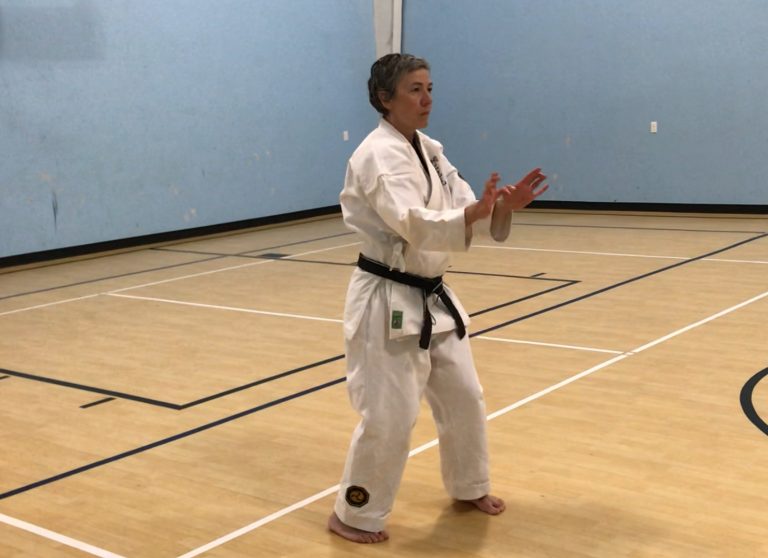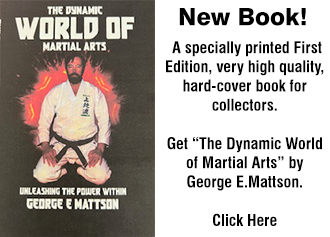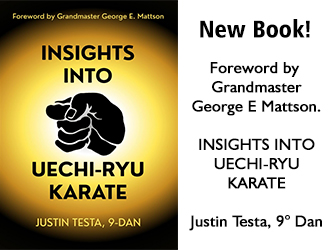by Kristin Amirault
I joined the Mattson Academy Virtual Dojo in June of 2020, but my Uechi-Ryu journey began in 1994. The majority of my Uechi-Ryu training prior to 2020 found me, a woman of 5’4″, always trying to become stronger and faster in my kata, bunkai, and prearranged kumites.
As a white belt, I was taught to do the hissing breath, engage my stomach muscles, use tension and be strong in my stance while Sensei would test my Sanchin – punching, striking and kicking various parts of my body. Then, when it was time to move, I would try to be as strong as I could in my movements. This also meant that I stayed tense.
Much later in my karate journey, I worked a lot with an instructor who was small like me. I greatly admired him. He was always fluid and graceful, yet also strong and powerful in his movement. The most frequent advice he gave me was to relax and be more fluid. The last time I trained with him before he passed away he told me, “You need to be smarter, not stronger.” All good advice, but I wasn’t sure how to do it – until I began training with Mattson Sensei and learning what he calls the Old Way.
Since training and performing my kata with the Old Way flow, I no longer think much about breathing or tension, nor do I do the hissing breath. Now, at the end of my kata, I’m no longer out of breath or tired. The relaxed flow and lack of tension while I’m performing is not putting a high demand for oxygen or strain on my body. My movements are more natural and efficient. My training prior to learning the Old Way, being tense and trying to figure out how to become stronger and faster, was not kind to my body. I spent over 15 years dealing with pain, discomfort and injury after injury – shoulders, elbow, hip, knee – all of which I attribute to that kind of training. In almost 3 years of training in the Old Way, focusing on flow, technique, acceleration, Kime and timing, I have had no new injuries. Training now, the only pain or discomfort I experience is from a couple of those old injuries, when I am not properly aligned in my technique or movement. Although my body is aging, it has not felt this good in many years.
Mattson Sensei and I were recently discussing the difference between how I train now compared to where I started. We talked about what I should be striving for in my training and how to attain it. Watching a black belt perform a strong kata or Sanchin testing, one might assume that they became that strong by practicing kata. But kata isn’t designed to build strength or muscles. It takes a long, long time to build muscle and have a strong body by only doing kata. The purpose of kata is to learn technique and build muscle memory by repeating and practicing movements until they can be performed efficiently and accurately, with little or no conscious thought.
So how do we build a strong body that can withstand attacks and keep going? With supplemental exercises. All karate styles have many kinds of exercises to supplement kata, to increase flexibility, to condition the body, build muscle and make the body strong. Your body doesn’t get strong by holding your breath and tightening up when the teacher is testing your Sanchin. Using dynamic tension in that manor builds the muscle memory to tighten everything when struck. But tense is not what you want to be when it’s time to move – especially when it’s time to fight or defend yourself. You cannot move quickly under tension. Using dynamic tension is having opposing muscles working against each other at the same time. This means that one muscle group has to overpower another to create movement, or one muscle group must relax before moving. Either way, just being relaxed and ready to move, as in the Old Way training, is going to be faster.
One of the supplemental exercises we do in Uechi-Ryu is Kote Kitai, or body conditioning. Kote Kitai, conditioning exercises involving the rubbing and striking of body parts, can be done with a partner or an object. Conditioning exercises help the body adapt to constant strikes and blows that we experience in our training and help us to overcome fear we might have of being struck. Conditioning exercises focus on strengthening areas of the body that are used for blocking and striking like the outer arm, areas which often get hit or kicked in training like the thighs, and areas which are struck less frequently such as the stomach. Rubbing body parts that are often struck in training helps to spread out minor bruises and increase blood supply. This aids in healing minor injuries like small bruises. Over time, as our conditioning and confidence to withstand strikes improves, the intensity can be gradually increased. Also, our potential to initiate time on target strikes should be evident. Serious injuries can occur from excessive conditioning. Care must be taken to avoid and protect the tendons, nerves, major blood vessels and the joints when doing conditioning exercises. Bruises in the bone and deep muscle can lead to serious complications. Surface bruises are to be expected from time to time when training, with gradual and consistent conditioning they should become less frequent.
In addition to body conditioning and strength building exercises, we also work to develop Kime – the quick flexing of muscles at the correct moment, and learn how to absorb impacts. All of this helps us deal with blows and stresses on the body. Essentially, what we are trying to achieve is what boxers have already figured out: how to move with unrestricted breathing, fluidly, without tension, and flexing – not tightening – of strong and well developed muscles when receiving a landed blow.
As karate instructors, when testing a student’s Sanchin stance, we should be testing their form and foundation and looking for their natural strength. All that is needed to do this is touching with the fingers. Striking and kicking the student is not necessary. If we pound and beat on students, this only causes them to tense up and freeze. We should also be looking for the momentary flinch reaction of Kime. This is all that is needed to deal with the pressure we exert on the student if the student has developed a strong body through exercise and strength training. As Mattson Sensei’s sensei, Ryuko Tomoyose, told him – when checking stances and doing our karate we need to teach our students and ourselves to, “Just relax. Just be there.”.





